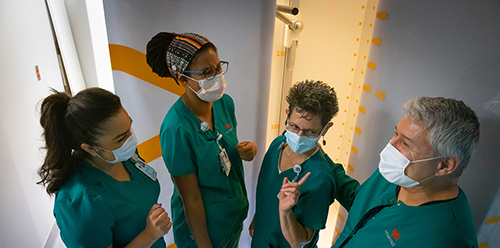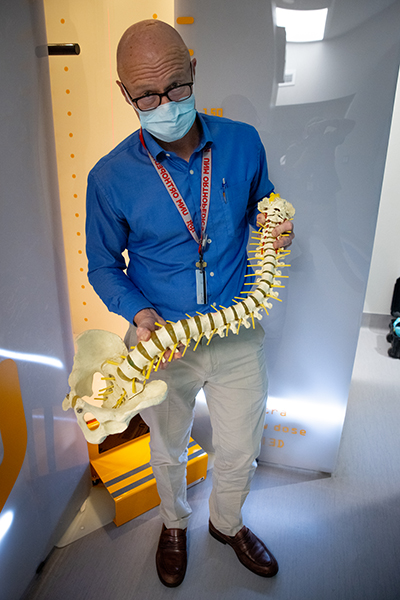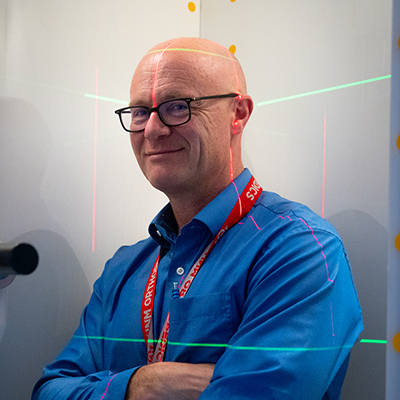Preparing for Disaster: UNM Hospital Participates in Region-Wide Emergency Training

Scoliosis Awareness Month
UNM Carrie Tingley Hospital is Home to New High-Tech Spinal Imaging System
 A new spinal imaging system – the first of its kind in the state – is in the final stages of being installed at UNM Carrie Tingley Hospital.
A new spinal imaging system – the first of its kind in the state – is in the final stages of being installed at UNM Carrie Tingley Hospital.
The high-tech machine’s installation coincides with National Scoliosis Awareness Month. Scoliosis is a sideways curvature of the spine that often occurs during the growth spurt just before puberty, though it also can be caused by conditions like cerebral palsy and muscular dystrophy. The cause of most scoliosis is unknown.
Low-dose 2D and 3D images from the futuristic-looking imaging machine are used for confirming a scoliosis diagnosis, monitoring scoliosis curve progression and planning for surgery, if needed. The new machine will be ready for use later this summer.
Patrick Bosch, MD, is a pediatric orthopedic surgeon at Carrie Tingley Hospital who specializes in scoliosis surgery. He completed his fellowship at Texas Scottish Rite Hospital for Children in Dallas, and recently returned to Carrie Tingley Hospital after 10 years at UPMC Children’s Hospital of Pittsburgh.
Children who are scanned for scoliosis with the new imaging system will be exposed to lower radiation than with a regular X-ray, Bosch says. This is notable because the average scoliosis patient will receive 10 to 25 spinal X-rays over several years of monitoring, according to a publication in the journal Dose-Response.

We’re rebuilding a great spine program here at home
“I think a lot of people currently are going to Denver children's and Phoenix children's (hospitals) for their spine care,” Bosch says. “We’re rebuilding a great spine program here at home.”
X-ray technician Jodi Ketcham adds that the new imaging system will take less time to complete a scan.
“This is going to make it easier on our scoliosis kids,” says Heather Pruitt, general radiology supervisor at Carrie Tingley Hospital. “Some are quadriplegic, paraplegic or have cerebral palsy.”
A scoliosis exam by a pediatrician during annual well-child visits can detect even a slight curve when a person bends over to touch her or his toes. The pediatrician can then make a referral to an orthopedic doctor.
“You want to identify scoliosis when it's still in the mild to moderate range, so that it has a chance to respond to nonoperative treatment, which is bracing,” Bosch says. “And you want to avoid getting into the higher magnitudes, which requires surgery. Screening and identifying it early so that you can identify candidates for bracing might allow patients to avoid the need for surgery. Well-check screening by a pediatrician still happens, and that's absolutely where it's picked up.”
Treatment can include having the child wear a brace. “Bracing is the only proven nonsurgical method of preventing curves from getting worse,” Bosch says. “It's 16-18 hours a day during growth. So yes, it's usually accompanied by tears. You do explain that, ‘No, it's not fair.’"
For advanced curvature, surgery may be required, he says. The goal is to prevent progression and obtain optimal, safe correction. About 50 surgeries are conducted each year at Carrie Tingley Hospital, Bosch says.
Building the spine program has been a team effort and includes support from many other pediatric specialties within the UNM Health System, Bosch says. Children also have access to orthotics to build the braces at Carrie Tingley.
For more information on the program and to schedule an appointment, call 505-272-4511.
Scoliosis Facts
- Scoliosis usually occurs in early adolescence and become more noticeable during a growth spurt.
- About 0.5 percent of young people who develop scoliosis require treatment.
- Girls are diagnosed with scoliosis eight times more often than boys.
- Sometimes scoliosis occurs in several family members over several generations.
Types of Scoliosis
- The most common type of scoliosis is idiopathic – meaning the cause is unknown. This can occur in infants, toddlers and younger children, but the majority of cases occur starting at 10 years of age until the child is fully grown.
- Congenital scoliosis begins forming very early in pregnancy.
- Neuromuscular scoliosis stems from any medical condition that affects the muscles and nerves. Examples include cerebral palsy, spina bifida and muscular dystrophy.